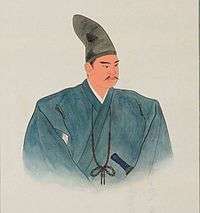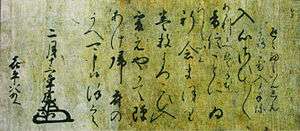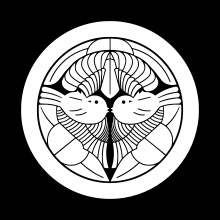Uesugi Kagekatsu
| Uesugi Kagekatsu 上杉 景勝 | |
|---|---|
 | |
| Preceded by | Uesugi Kenshin |
| Succeeded by | Uesugi Sadakatsu |
| Personal details | |
| Born |
January 8, 1556 Echigo Province, Japan |
| Died |
April 19, 1623 (aged 67) Yonezawa, Japan |
| Nationality | Japanese |

Uesugi Kagekatsu (上杉 景勝, 8 January 1556 – 19 April 1623) was a Japanese samurai daimyō during the Sengoku period and Edo period.[1]
Early life
Kagekatsu was the son of Nagao Masakage, the head of the Ueda Nagao clan and husband of Uesugi Kenshin's elder sister, Aya-Gozen. After his father died, he was adopted by Kenshin.
Daimyo
Upon Kenshin's death in 1578, Kagekatsu battled Kenshin's other adopted son Uesugi Kagetora for the inheritance, defeating him in the 1578 Siege of Ōtate. He forced Kagetora to commit seppuku, and became head of the Uesugi clan. Kagekatsu married Takeda Katsuyori's sister (Takeda Shingen's daughter) after the Siege of Ōtate.
As a general under Toyotomi Hideyoshi, Kagekatsu took part in the Odawara and Korea campaigns, and rose to prominence to become a member of the council of Five Elders. Originally holding a 550,000 koku fief in Echigo Province, Kagekatsu received the fief of Aizu, worth a huge 1.2 million koku when Hideyoshi redistributed holdings in 1598. After Hideyoshi's death, that year, Kagekatsu then allied himself with Ishida Mitsunari, against Tokugawa Ieyasu, as the result of some political dispute.
The Sekigahara Campaign can be said to have begun, at least in part, with Kagekatsu, who was the first daimyo to plan a revolt against the Tokugawa. He built a new castle in Aizu, attracting the attention of Ieyasu, who ordered him to Osaka, to explain his conduct. Kagekatsu refused, and Tokugawa began plans to lead a 50,000 man army north against him. Ishida and Uesugi hoped to occupy Tokugawa Ieyasu with this fighting in the north, distracting him from Ishida Mitsunari's attacks in and around Osaka. Anticipating this, Ieyasu remained in Osaka to engage Mitsunari; his generals Mogami Yoshiaki and Date Masamune would fight Kagekatsu in Tōhoku (northern region Honshū, Japan's main island). Kagekatsu had intended to move his force south, attacking the Tokugawa from the north-east while Ishida attacked from the west, but he was defeated very early in the campaign, at the siege of his castle at Shiroishi.
Declaring his allegiance to Tokugawa following his defeat, Kagekatsu became a tozama (outsider) daimyo; he was given the Yonezawa han, worth 300,000 koku, in the Tōhoku region. Kagekatsu would later fight for the Tokugawa shogunate against the Toyotomi clan in the 1614–15 siege of Osaka.
See also
References

Further reading
- Frederic, Louis (2002). "Japan Encyclopedia." Cambridge, Massachusetts: Harvard University Press.
- Sansom, George (1961). "A History of Japan: 1334-1615." Stanford, California: Stanford University Press.
- Turnbull, Stephen (1998). 'The Samurai Sourcebook'. London: Cassell & Co.
| Japanese royalty | ||
|---|---|---|
| Preceded by Uesugi Kenshin |
Uesugi family head 1580–1623 |
Succeeded by Uesugi Sadakatsu |